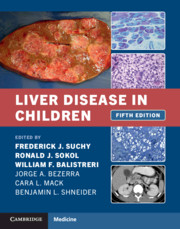Book contents
- Liver Disease in Children
- Liver Disease in Children
- Copyright page
- Contents
- Contributors
- Preface
- Section I Pathophysiology of Pediatric Liver Disease
- Section II Cholestatic Liver Disease
- Chapter 8 Approach to the Infant with Cholestasis
- Chapter 9 Medical and Nutritional Management of Cholestasis in Infants and Children
- Chapter 10 Neonatal Hepatitis and Congenital Infections
- Chapter 11 Biliary Atresia and Other Disorders of the Extrahepatic Bile Ducts
- Chapter 12 Neonatal Jaundice and Disorders of Bilirubin Metabolism
- Chapter 13 Familial Hepatocellular Cholestasis
- Chapter 14 Alagille Syndrome
- Chapter 15 Intestinal Failure Associated Liver Disease
- Chapter 16 Diseases of the Gallbladder in Infancy, Childhood, and Adolescence
- Section III Hepatitis and Immune Disorders
- Section IV Metabolic Liver Disease
- Section V Other Considerations and Issues in Pediatric Hepatology
- Index
- References
Chapter 9 - Medical and Nutritional Management of Cholestasis in Infants and Children
from Section II - Cholestatic Liver Disease
Published online by Cambridge University Press: 19 January 2021
- Liver Disease in Children
- Liver Disease in Children
- Copyright page
- Contents
- Contributors
- Preface
- Section I Pathophysiology of Pediatric Liver Disease
- Section II Cholestatic Liver Disease
- Chapter 8 Approach to the Infant with Cholestasis
- Chapter 9 Medical and Nutritional Management of Cholestasis in Infants and Children
- Chapter 10 Neonatal Hepatitis and Congenital Infections
- Chapter 11 Biliary Atresia and Other Disorders of the Extrahepatic Bile Ducts
- Chapter 12 Neonatal Jaundice and Disorders of Bilirubin Metabolism
- Chapter 13 Familial Hepatocellular Cholestasis
- Chapter 14 Alagille Syndrome
- Chapter 15 Intestinal Failure Associated Liver Disease
- Chapter 16 Diseases of the Gallbladder in Infancy, Childhood, and Adolescence
- Section III Hepatitis and Immune Disorders
- Section IV Metabolic Liver Disease
- Section V Other Considerations and Issues in Pediatric Hepatology
- Index
- References
Summary
When first encountering an infant or child with cholestatic liver disease, it is essential that diagnostic evaluation be conducted promptly in order to recognize disorders amenable either to specific medical therapy (e.g., galactosemia, tyrosinemia, hypothyroidism, urinary tract infection) or to early surgical intervention (e.g., biliary atresia, choledochal cyst); institute treatment directed toward enhancing bile flow; and prevent and treat the varied medical, nutritional, and emotional consequences of chronic liver disease.
- Type
- Chapter
- Information
- Liver Disease in Children , pp. 116 - 146Publisher: Cambridge University PressPrint publication year: 2021
References
- 2
- Cited by

